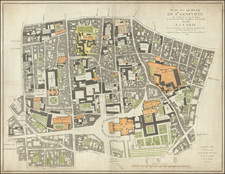Search
Jacques-Germain Soufflot was a French architect in the international circle that introduced neoclassicism. His most famous work is the Panthéon in Paris, built from 1755 onwards, originally as a church dedicated to Saint Genevieve.
In the 1730s, Soufflot attended the French Academy in Rome, where young French students in the 1750s would later produce the first full-blown generation of Neoclassical designers.
After returning to France, Soufflot practiced in Lyon, where he built the Hôtel-Dieu. With the Temple du Change, he was entrusted with completely recasting a 16th-century market exchange building housing a meeting space housed above a loggia.
Soufflot returned to Rome in 1750 in the company of the future Marquis de Marigny, the talented young brother of Madame de Pompadour, who was being groomed for his future as director of the King's Buildings (Bâtiments du Roi). On this trip Soufflot made a special study of theaters. In 1755 Marigny, the new Director General of Royal Buildings, gave Soufflot architectural control of all the royal buildings in Paris. In the same year, he was admitted to the Royal Academy of Architecture. In 1756 his opera house opened in Lyon.
The Panthéon Soufflot's his most famous work, but the Hôtel Marigny built for his young patron (1768–1771) across from the Élysée Palace, is a better definition of Soufflot's personal taste. Soufflot died in Paris in 1780.
Like all the architects of his day, Soufflot considered the classical idiom essential. He stood out for his "strictness of line, firmness of form, simplicity of contour, and rigorously architectonic conception of detail" which contrasted sharply with the late Baroque and Rococo architecture of his contemporaries.

